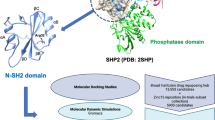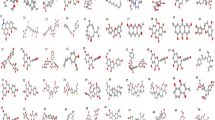Abstract
The normal expression of SHP2 protein is a key factor in the production and action of cancer cells. Highly active SHP2 inhibitors could inhibit the promotion effect of SHP2 protein on cancer cells to effectively treating cancer. The QSAR modeling methods of 3D-QSAR (Topomer CoMFA) and HQSAR were utilized to discuss the relationship between the SHP2 inhibitory activity and the molecular structures of 35 inhibitors. A reliable and predictive model was obtained through different cutting methods and fragment combinations (Topomer CoMFA with q2 = 0.803, r2 = 0.996, \( {r}_{\mathrm{pred}}^2 \) = 0.817; HQSAR with q2 = 0.767, r2 = 0.959, \( {r}_{\mathrm{pred}}^2 \) = 0.876). Through the search of the R-group in Topomer search module and the combination of the higher activity contributing groups in the existing molecules, 18 new compounds with theoretically high anti-SHP2 activity were obtained. The docking results with SHP2 protein compared to the original ligand showed that most of the 18 new compounds could generate stable combinations in the form of hydrogen bonds. The prediction results of ADMET properties and drug-like properties indicate that they are eligible to become drugs, which is expected to become potential anti-SHP2 inhibitors and provide a certain amount of reference to foster the synthesis of SHP2 inhibitors.








Similar content being viewed by others
Data availability
All data generated or analyzed during this study are included in the article and supplementary materials.
References
Frankson R, Yu Z-H, Bai Y, Li Q, Zhang R-Y, Zhang Z-Y (2017) Therapeutic targeting of oncogenic tyrosine phosphatases. Cancer Res 77:5701–5705
Barford D, Neel BG (1998) Revealing mechanisms for SH2 domain mediated regulation of the protein tyrosine phosphatase SHP-2. Structure 6:249–254
Hui E, Cheung J, Zhu J, Su X, Taylor MJ, Wallweber HA et al (2017) T cell costimulatory receptor CD28 is a primary target for PD-1-mediated inhibition. Science (80-) 355:1428-+
Pluskey S, Wandless TJ, Walsh CT, Shoelson SE (1995) Potent stimulation of SH-PTP2 phosphatase activity by simultaneous occupancy of both SH2 domains. J Biol Chem 270:2897–2900
Tartaglia M, Mehler EL, Goldberg R, Zampino G, Brunner HG, Kremer H et al (2001) Correction: mutations in the protein tyrosine kinase gene, PTPN11, cause Noonan syndrome. Nat Genet 29:491–491
Loh ML, Vattikuti S, Schubbert S, Reynolds MG, Carlson E, Lieuw KH et al (2004) Mutations in PTPN11 implicate the SHP-2 phosphatase in leukemogenesis. Blood 103:2325–2331
Tang C, Luo D, Yang H, Wang Q, Zhang R, Liu G, Zhou X (2013) Expression of SHP2 and related markers in non-small cell lung cancer: a tissue microarray study of 80 cases. Appl Immunohistochem Mol Morphol 21(5):386–94
Zhao M, Guo W, Wu Y, Yang C, Zhong L, Deng G et al (2019) SHP2 inhibition triggers anti-tumor immunity and synergizes with PD-1 blockade. Acta Pharm Sin B 9:304–315
Chen Y-NP, LaMarche MJ, Chan HM, Fekkes P, Garcia-Fortanet J, Acker MG et al (2016) Allosteric inhibition of SHP2 phosphatase inhibits cancers driven by receptor tyrosine kinases. Nature 535:148-+
Sun X, Ren Y, Gunawan S, Teng P, Chen Z, Lawrence HR et al (2018) Selective inhibition of leukemia-associated SHP2(E69K) mutant by the allosteric SHP2 inhibitor SHP099. Leukemia 32:1246–1249
Wang S, Battigelli A, Alkekhia D, Fairman A, Antoci V, Yang W et al (2020) Controlled delivery of a protein tyrosine phosphatase inhibitor, SHP099, using cyclodextrin-mediated host-guest interactions in polyelectrolyte multilayer films for cancer therapy. RSC Adv 10:20073–20082
Fodor M, Price E, Wang P, Lu H, Argintaru A, Chen Z et al (2018) Dual allosteric inhibition of SHP2 phosphatase. ACS Chem Biol 13:647–656
Sarver P, Acker M, Bagdanoff JT, Chen Z, Chen Y-N, Chan H et al (2019) 6-Amino-3-methylpyrimidinones as potent, selective, and orally efficacious SHP2 inhibitors (vol 62, pg 1793, 2019). J Med Chem 62:3781–3781
Abedi H, Ebrahimzadeh H, Ghasemi JB (2013) 3D-QSAR, CoMFA, and CoMSIA of new phenyloxazolidinones derivatives as potent HIV-1 protease inhibitors. Struct Chem 24:433–444
Xavier MM, Heck GS, de Avila MB, Bernhardt Levin NM, Pintro VO, Carvalho NL et al (2016) SAnDReS a computational tool for statistical analysis of docking results and development of scoring functions. Comb Chem High Throughput Screen 19:801–812
Tong J, Lei S, Qin S, Wang Y (2018) QSAR studies of TIBO derivatives as HIV-1 reverse transcriptase inhibitors using HQSAR, CoMFA and CoMSIA. J Mol Struct 1168:56–64
Liu W-S, Yang B, Wang R-R, Li W-Y, Ma Y-C, Zhou L et al (2020) Design, synthesis and biological evaluation of pyridine derivatives as selective SHP2 inhibitors. Bioorg Chem 100:103875
Clark M, Cramer R, Opdenbosch N, Iii R (1989) Validation of the general purpose TRIPOS 5.2 force field. J Comput Chem 10:982–1012
Ding W, Sun M, Luo S, Xu T, Cao Y, Yan X et al (2013) A 3D QSAR study of betulinic acid derivatives as anti-tumor agents using Topomer CoMFA: model building studies and experimental verification. Molecules 18:10228–10241
Stahle L, Wold S (1988) Multivariate data analysis and experimental design in biomedical research. Prog Med Chem 25:291–338
Jilek RJ, Cramer RD (2004) Topomers: a validated protocol for their self-consistent generation. J Chem Inf Comput Sci 44:1221–1227
Zhu W, Chen G, Hu L, Luo X, Gui C, Luo C et al (2005) QSAR analyses on ginkgolides and their analogues using CoMFA, CoMSIA, and HQSAR. Bioorg Med Chem 13:313–322
Waller CL (2004) A comparative QSAR study using CoMFA, HQSAR, and FRED/SKEYS paradigms for estrogen receptor binding affinities of structurally diverse compounds. J Chem Inf Comput Sci 44:758–765
Chavda J, Bhatt H (2019) 3D-QSAR (CoMFA, CoMSIA, HQSAR and topomer CoMFA), MD simulations and molecular docking studies on purinylpyridine derivatives as B-Raf inhibitors for the treatment of melanoma cancer. Struct Chem 30:2093–2107
Kitchen DB, Decornez H, Furr JR, Bajorath J (2004) Docking and scoring in virtual screening for drug discovery: methods and applications. Nat Rev Drug Discov 3:935–949
Tomasic T, Kovac A, Klebe G, Blanot D, Gobec S, Kikelj D et al (2012) Virtual screening for potential inhibitors of bacterial MurC and MurD ligases. J Mol Model 18:1063–1072
Sterling T, Irwin JJ (2015) ZINC 15-ligand discovery for everyone. J Chem Inf Model 55:2324–2337
Tong J-B, Bai M, Zhao X (2016) 3D-QSAR and docking studies of HIV-1 protease inhibitors using R-group search and Surflex-dock. Med Chem Res 25:2619–2630
Liao SY, Qian L, Miao TF, Shen Y, Zheng KC (2009) 3D-QSAR studies of substituted 4-aryl/heteroaryl-4h-chromenes as apoptosis inducers using CoMFA AND CoMSIA. J Theor Comput Chem 8:143–155
Wu X-Y, Chen W-H, Wu S-G, Tian Y-X, Zhang J-J (2012) Pyrrolo 3,2-d pyrimidine derivatives as type II kinase insert domain receptor (KDR) inhibitors: CoMFA and CoMSIA studies. Int J Mol Sci 13:2387–2404
Hodgson J (2001) ADMET--turning chemicals into drugs. Nat Biotechnol 19:722–726
Zhang S (2011) Computer-aided drug discovery and development. Methods Mol Biol 716:23–38
Gleeson MP (2008) Generation of a set of simple, interpretable ADMET rules of thumb. J Med Chem 51:817–834
Yang H, Lou C, Sun L, Li J, Cai Y, Wang Z et al (2019) admetSAR 2.0: web-service for prediction and optimization of chemical ADMET properties. Bioinformatics 35:1067–1069
Daina A, Michielin O, Zoete V (2017) SwissADME: a free web tool to evaluate pharmacokinetics, drug-likeness and medicinal chemistry friendliness of small molecules. Sci Rep 7:42717
Clark RD, Strizhev A, Leonard JM, Blake JF, Matthew JB (2002) Consensus scoring for ligand/protein interactions. J Mol Graph Model 20:281–295
Lipinski C, Lombardo F, Dominy B, Feeney P (2001) Experimental and computational approaches to estimate solubility and permeability in drug discovery and development settings1. Adv Drug Deliv Rev 46:3–26
Lipinski CA (2004) Lead- and drug-like compounds: the rule-of-five revolution. Drug Discov Today Technol 1:337–341
Funding
This work was supported by the National Natural Science Funds of China (21475081), the Natural Science Foundation of Shaanxi Province of China (2019JM-237), and the Graduate Innovation Fund of Shaanxi University of Science and Technology.
Author information
Authors and Affiliations
Contributions
All authors contributed to the study conception and design. Material preparation and data collection were performed by Jian-Bo Tong, Ding Luo, Xing Zhang, and Shuai Bian. Data analysis was performed by Jian-Bo Tong. The first draft of the manuscript was written by Ding Luo and all authors commented on previous versions of the manuscript. All authors read and approved the final manuscript.
Corresponding author
Ethics declarations
Conflict of interest
The authors declare that they have no conflict of interest.
Consent to participate
Not applicable.
Consent for publication
Not applicable.
Additional information
Publisher’s note
Springer Nature remains neutral with regard to jurisdictional claims in published maps and institutional affiliations.
Supplementary information
ESM 1
(DOCX 1906 kb)
Rights and permissions
About this article
Cite this article
Tong, JB., Luo, D., Zhang, X. et al. Design of novel SHP2 inhibitors using Topomer CoMFA, HQSAR analysis, and molecular docking. Struct Chem 32, 1061–1076 (2021). https://doi.org/10.1007/s11224-020-01677-8
Received:
Accepted:
Published:
Issue Date:
DOI: https://doi.org/10.1007/s11224-020-01677-8




